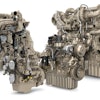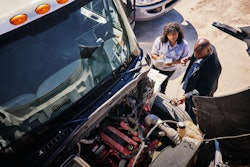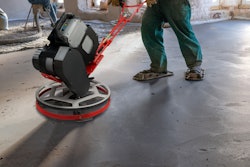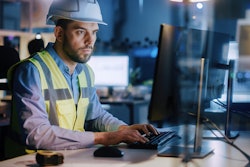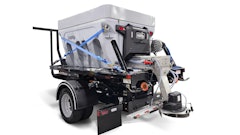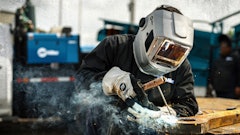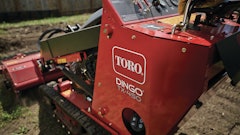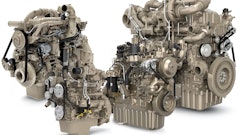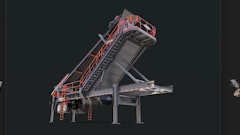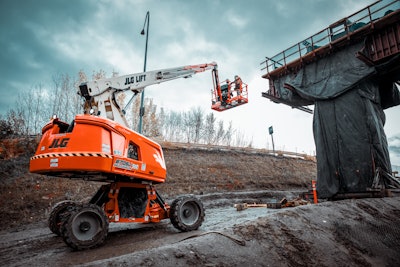
Equipment with a traditional oscillating axle may struggle to operate with the boom elevated, out from the transport position to access. That’s because these machines are only rated to work on firm, level surfaces (with 5 degrees or less of grade). And most jobsites aren’t flat.
These situations require operators to put in extra effort to get work done at height. They also must find alternatives to improve operations, productivity and efficiencies in the field with:
- Constant repositioning
- Additional jobsite preparation, including ground leveling
- Employing a bigger machine with further reach to access the work area from a level spot beyond where they’d ideally like to place the machine
- Using multiple machines
- Cribbing the machine on a localized platform to attain a level work surface
- Shoring up the ground or stone leveling a raceway to attain a level work surface
To address this, access equipment designs are going through a significant transformation. Today’s machines look and operate differently than previous generations. It’s no longer about general specification updates. It’s about combining innovation with technology to solve the most common jobsite challenges, like working on uneven or inclined terrain, to maximize productivity and enhance safety.
Solving Real-World Jobsite Challenges
 This boom lift has self-leveling technologyJLG Industries
This boom lift has self-leveling technologyJLG Industries
While these advancements are promising and have a place in the market, the access industry's future will be OEMs developing practical technology solutions nearer to ground level, introducing the concept of a smarter chassis to work along changing ground conditions and improve operators’ productivity.
Emerging Technologies Focus on Ground-Level Innovations
Smarter chassis technologies help operators work on undeveloped surfaces and improved surfaces where infrastructure is already established including:
- City centers, where operators want to get closer to buildings but can’t because of the imbalance in height between the streets
- Curbs and sidewalks
- Work on or near bridges and overpasses
- Other jobsites with extremely limited space because of ongoing traffic or water obstacles
This type of ground-level technology eliminates the need for excessive, costly jobsite preparation, such as grading work, to level surfaces. It also eliminates the need for cribbing so that these machines can be used on more jobsites. In addition, the technology allows machines to work closer to buildings with less positioning.
Variable-Tilt Technology Helps Work on Changing Terrain
 This scissor lift is equipped with quick leveling technology.JLG Industries
This scissor lift is equipped with quick leveling technology.JLG Industries
Variable-tilt technology is currently used in slab scissor lifts. The first evolution of this technology focused on modifying the machine’s lift height or work envelope based on the tilt of the chassis (assuming the machine is fully loaded).
A new, modern version takes this technology a step further. It considers the tilt and actual load of the platform, measured by the load sensing system, to define how high the operator can lift the platform.
It determines the allowable work envelope using sensors that monitor the platform's weight and the machine’s tilt. The machine then notifies operators on the platform-mounted LCD screen about how high they can elevate before raising it.
The display also communicates the machine’s:
- Side-to-side and front-to-back tilt
- Amount of weight on the platform
- Current height of the platform
- Maximum height at which the operators can raise the mobile elevating work platform (MEWP) by considering those factors
This means that operators can determine if they should the amount of material they take with them or if they need to get to move to a spot that's a little more level on the jobsite to get the full height. This technology removes the guesswork that often forces operators to descend and try again.
Another advancement in this technology, available on telehandlers and rough-terrain scissor lifts, equips the machines with quick-leveling capabilities. On telehandlers, this is called sway. It uses two oscillating axles that allow operators to manually level the machine (roll control).
 Variable-tilt technology considers the tilt and actual load of the platform to define how high the operator can lift the platform.JLG Industries
Variable-tilt technology considers the tilt and actual load of the platform to define how high the operator can lift the platform.JLG Industries
With traditional leveling jacks, the operator must fully lower the machine, retract the jacks, drive to a new spot and repeat operations—lowering the jacks, leveling the machine and then lifting the deck to the appropriate height. Compared to leveling jacks, which require several manual adjustments, this technology offers significant time savings and operating efficiency.
Self-Leveling for Boom Lifts
 With self-leveling technology, cribbing or grading on the jobsite is not required.JLG Industries
With self-leveling technology, cribbing or grading on the jobsite is not required.JLG Industries
Self-leveling technology is designed to adjust the boom lift’s chassis to the ground conditions (rather than adjust the machine’s capability to ground conditions). It levels itself automatically in all directions, even when driving the unit elevated.
With this technology, the machine's control system assures that all four wheels constantly contact the ground, improving the machine’s traction on rugged terrain. The benefits of this are that:
- Operators (and occupants) will feel more stable during travel because of less bouncing when it travels over rough or uneven terrain.
- It minimizes the need to crib and/or grade the work area and eliminates the trial and effort of repositioning to find level ground.
Industry Compliance Is Required
 A scissor lift equipped with variable tilt technologyJLG Industries
A scissor lift equipped with variable tilt technologyJLG Industries
For example, these machines are now required to have load-sensing capabilities that actively monitor loads, sound an alarm and interrupt normal operations if overloaded. They must also have a tilt sensor system that will alarm and disable the boom and drive functions if the incline surpasses the slope limit. This means that machines with smart chassis technology will allow operators to complete their work more easily without extra preplanning.
Looking Ahead
These are step changes for the access industry—technologies that will truly transform how people work at height by increasing productivity and enhancing safety best practices. As technology evolves, these innovations will change how the industry works today, and they be the way forward.



